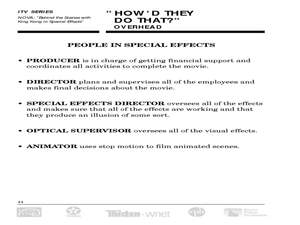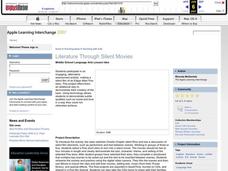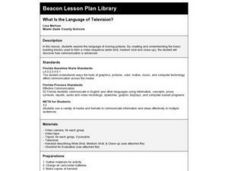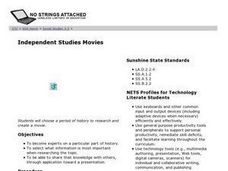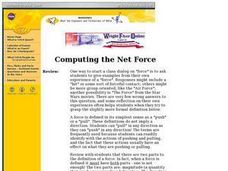Curated OER
Thumbs Up For Movie Reviews
If your class loves movies, this lesson is sure to interest them. After discussing the purpose and structure of movie reviews, young writers compose a movie review and discuss why people may read a review before they go see a film. The...
Curated OER
What's so Special about SFX?
Students work individually or in small groups to design a series of special effects images. They use image editing software to explore how visual information is interpreted and manipulated digitally. Students create new, blank image...
Curated OER
Science of Special Effects
This is a creative, multidisciplinary, well-designed instructional activity provided by Scientific American related to special effects. Students make their own animated short films and use math and computer skills.
Star Wars in the Classroom
"Shakespeare and Star Wars": Lesson Plan Days 13 and 14
How important are sound effects in films? In stage plays? In radio programs? To gain an understanding of the impact of these special effects, class members watch a short video spoof of the sound in a scene from Star...
Curated OER
How'd They Do That?
Students research the movie production occupation and careers in the industry. In this movie careers and effects instructional activity, students watch a video about special effects used in movies and scale. Students draw a building to a...
Curated OER
Literature Through Silent Movies
Students participate in an engaging, alternative assessment activity: making a silent film of an Edgar Allen Poe story. This project offers them an additional way to demonstrate their mastery of the topic.
Curated OER
Literature Through Silent Movies
Young scholars watch Charlie Chaplin films and discuss film elements. They select a story written by Edgar Allen Poe to write and produce a movie of. They film scenes, edit, and create a final iMovie project.
Curated OER
: Movies: How do they work, how does the science world use them?
Students explore how movies are made and what equipment is involved in making a movie. In this movie lesson students view video on film making and brainstorm ways to make a film.
Media Smarts
Thinking About Television and Movies
As part of their study of the influence of TV and films, class members consider how music, lighting, costumes, camera angles, etc. are used to influence the response of viewers.
Curated OER
Flat Stanley Visits....Your Imagination in Claymation!
In this literature activity, young scholars read the Jeff Brown book Flat Stanley and collaborate to create claymation characters from the story. Students create a claymation video and discuss using word cards during hte movie.
Curated OER
Nursery Rhyme Modernization
Students retell a nursery rhyme updating it and create a video. In this Movie Maker nursery rhyme lesson, students use technology to update a nursery rhyme. Students incorporate special effects, actions, and captured...
Curated OER
Digital Photography for Movie Making
Fifth graders explore digital photography. In this technology skills lesson, 5th graders take digital photographs and use them to create movies with movie maker software.
Curated OER
What Is the Language of Television?
Sixth graders explore the language of moving pictures. By creating and understanding the basic building blocks used to form a video sequence (wide shot, medium shot and close-up),they discover how communication is enhanced. A great,...
Film Education
Gone with the Wind Study Guide
The 1939 Oscar-winning Gone with the Wind, is the focus of an informational packet designed to be used with a viewing of the film. As part of their analysis, media students respond to a series of discussion points about the...
It's About Time
Organic Substances
Host an exciting lab in which learners burn fruit rinds to better understand hydrocarbons. A reading passage and analysis questions wrap up the lesson.
Curated OER
Behind the Movie Chicago
Students explore the genre of the musical film and its history. They draw conclusions on relationships between a stage musical and a musical film. They share the results of their research as a class.
Curated OER
Independent Studies Movies
History comes alive as groups work cooperatively to create short iMovies about a specific historical period of their choice. Ideal for late elementary grades, the lesson includes a video demonstration and a short materials list.
Curated OER
Technology in the English Classroom
There are many ways to use technology to enhance literature and English lessons.
Curated OER
The Physics of Sports: An 8th Grade Physical Science Project
Explore the relationship between sports and physics in a cross-curricular lesson. Middle and high schoolers prepare a multimedia presentation based on a chosen sport. They answer five physics vocabulary questions about how the laws of...
Curated OER
The History of Rock and Roll: Part 10 - Up From the Underground - Lesson 1
Students discuss the effect music videos have had on the role of the music. They examine how developments in technology have effected the music industry.
It's About Time
Metals and Nonmetals
Did you know you can melt the metal gallium with just the heat of your hand? Pupils observe and test materials in order to classify them as metal or non-metal. A reading passage and analysis questions wrap up the lesson.
It's About Time
Identifying Matter
High schoolers test wood splints that have been soaked in mystery solutions to identify the different colors it produces when lit. The lesson concludes with a reading passage and analysis questions.
Curated OER
Culture Creation vs. Culture Consumption - Finding Voice Through Digital Storytelling
Ninth graders explore the power of media in culture and Gandhi's philosophy of nonviolence. In this nonviolence and media lesson, 9th graders analyze Gandhi's nonviolent methods for social change and discuss the media's power to create...
Curated OER
Computing the Net Force
Adorable little stick figures push and pull a cart of blocks to explain the push and pull of forces. Future physicists then define force and identify it in different situations on the learning exercise that follows. Concepts covered...




